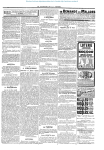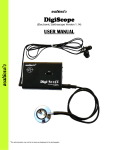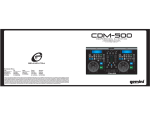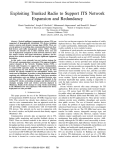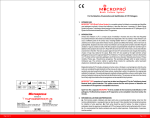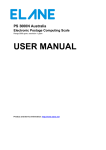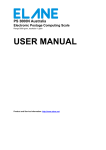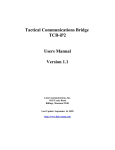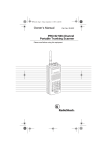Download Radio Shack 200 Owner`s manual
Transcript
OWNER'S MANUAL
-c
PRO-2037
Programmable Scanner
Please read before using this equipment.
-
\
1-
~
~~-.£~~
~
.
=-
~~
~V~·
\0 .,..
~
"''''''~
.
@)
F-
~~
0,-'
~'~/
"""~
() "'"
,..,
~O~0""
...•
0011 @
~
'40~~
()~o~
/
.CXllO-12D
V-
•...---
Cat. No. 20-461
ltadie/MeIt
INTRODUCTION
Your new Radio Shack PRO-2037
Programmable Scanner lets you in on
all the action! This scanner gives you
direct access to more than 31,000 frequencies that include police and fire
departments,
aircraft
communications, amateur radio, and ambulance
and transportation services. You can
select up to 200 channels to scan and
you can change your selection at any
time.
The secret to your scanner's ability to
scan so many frequencies is its custom-designed microprocessor-a tiny,
built-in computer.
Your scanner also has these special
features:
Hyperscan - scans 25 channels per
second and searches 50 frequencies
per second.
Headphones Jack - lets you connect a pair of headphones or an external speaker.
Triple
Conversion
Superheterodyne - eliminates any interference
from IF (Intermediate Frequency) images, so you only hear the selected
frequency.
Ten Channel-Storage
Banks - let
you store 20 channels in each of ten
banks to group channels so calls are
easier to identify.
Monitor Memories - let you temporarily save up to ten channels you locate during a frequency search.
Two-Second Channel Scan Delay
- delays scanning for 2 seconds before moving to another channel so
you can hear more replies.
Lockout Function - keeps selected
channels from being scanned so you
can skip over them.
Priority Channel - checks a channel you select every 2 seconds to
keep you from missing important
calls.
AM/FM Mode - automatically
selects the most common reception type
for the band you are scanning, and
lets you override the selection.
ATT Switch - reduces the scanner's
sensitivity to strong local signals.
Memory Backup - keeps channel
frequencies stored in memory for up
to 1 hour during a power loss.
Liquid-Crystal Display - shows the
selected channel and frequency.
Note: Mobile use of this scanner is
unlawful or requires a permit in some
areas. Check the laws in your area.
For your important records, please record your scanner's serial number in
the space provided. The serial number is located on the back of the
scanner.
Serial Number:
© 1994 Tandy Corporation.
All Rights Reserved.
Radio Shack is a registered trademark used by Tandy Corporation.
2
_
Your PRO-2037 covers the following
bands:
30 - 50 MHz (VHF Lo)
50 - 54 MHz (6-Meter Ham Band)
118 - 136.975 MHz (Aircraft)
137 -144
MHz (Government)
144 - 148 MHz (2-Meter Ham Band)
148 -174
MHz (VHF Hi)
380 - 450 MHz (Ham Radio and Government)
450 - 470 MHz (UHF Lo)
470 - 512 MHz (UHF TV)
FCC NOTICE
Your scanner might cause radio or TV
interference, even when it is operating properly. To determine whether
your scanner is causing the interference, turn off your scanner. If the interference goes away, your scanner is
causing the interference, Try to eliminate the interference by:
• Moving your scanner away from
the receiver
• Connecting your scanner to an outlet that is on a different electrical
circuit from the receiver,
• Contacting your local Radio Shack
store for help
806 - 823.9875 MHz (UHF Hi)
849.0125 - 868.9875 MHz (UHF Hi)
894.0125 - 960 MHz (UHF Hi)
If you cannot eliminate the interference, the FCC requires that you stop
using your scanner.
This device complies with Part 15 of
FCC Rules. Operation is subject to
the following conditions: (1) This device must not cause harmful interference, and (2) this device must accept
any interference received, including
interference that may cause undesired operation.
Ir\
This symbol is intended to
alert you to the presence of
dangerous voltage inside the
product that presents a risk of electric
shock. Do not open the product's
case.
ill
CAUTION: TO REDUCE THE RISK OF ELECTRIC SHOCK,
DO NOT REMOVE
SERVICEABLE
COVER
(OR BACK).
0 USER·
PARTS INSIDE. REFER SERVICI
G TO
QUALIFIED SERVICE PERSONNEl.
~!
This symbol is intended to tell
you that important operating
and maintenance instructions
are contained in this owner's manual.
~
Warning: To reduce the risk of fire
or electric shock, do not expose
this appliance to rain or moisture.
3
•
CONTENTS
PREPARATION
Connecting the Antenna
Connecting an Optional Antenna
Connecting Power
Connecting AC Power
Connecting DC Power
Resetting and Initializing the Scanner
Resetting the Scanner's Display
Initializing the Scanner
Connecting Headphones
Listening Safely
Traffic Safety
Connecting an External Speaker
6
6
6
7
7
8
8
8
9
9
9
10
10
UNDERSTANDING YOUR SCANNER
A Look at the Keyboard
A Look at the Display
11
11
12
UNDERSTANDING MEMORY
Channel-Storage Banks
Monitor Memories
13
13
13
OPERATION
Turning On the Scanner/Setting Volume and Squelch
Scanning the Channels
Turning Channel-Storage Banks On and Off
Storing Frequencies
Searching For and Temporarily Storing Active Frequencies
Limit Search
Direct Search
Moving a Frequency From a Monitor Memory to a Channel
Manually Selecting a Channel
14
14
14
14
15
15
16
16
17
17
4
SPECIAL FEATURES
Changing the AM/FM Mode
Delay
Locking Out a Channel
Priority
Using the ATT Switch
18
18
18
19
19
20
A GENERAL GUIDE TO SCANNING
Guide to Frequencies
National Weather Frequencies
Ham Radio Frequencies
Birdies
Guide to the Action Bands
Typical Band Usage
Primary Usage
Specified Intervals
Band Allocation
Frequency Conversion
21
21
21
21
22
23
23
24
24
25
27
TROUBLESHOOTING
28
CARE AND MAINTENANCE
29
SPECIFICATIONS
30
5
PREPARATION
This scanner is primarily designed for
use in the home as a base station.
You can place it on a desk, shelf, or
table.
Your scanner's front feet fold up or
down. Adjust them to give you the
best view of the display.
The scanner's sensitivity depends on
the antenna's length and various environmental conditions. For the best reception of the transmissions you want
to hear, adjust the antenna length.
Frequency
30-174
Antenna Length
MHz extend fully
380 - 512 MHz extend 2 segments
806 - 960 MHz collapse fully
(1 segment only)
Connecting an Optional
Antenna
CONNECTING THE
ANTENNA
To attach the supplied telescoping antenna, simply screw it clockwise into
the hole on the scanner's top.
The telescoping antenna is adequate
for strong local signals. But, for improved reception, you can connect a
multi-band outdoor antenna (not supplied) to the scanner. Your local Radio
Shack store sells a variety of antennas. Choose the one that best meets
your needs.
When deciding on an outdoor base
antenna and its location, consider the
following:
• The location of the antenna should
be as high as possible.
• The antenna and antenna cable
should be as far as possible from
sources of electrical noise (appliances, other radios, and so on).
• The antenna should be vertical for
the best performance.
6
To connect an optional antenna, always
use 50-ohm coaxial cable, such as RG58 or RG-8. For lengths over 50 feet,
use RG-8 low-loss dielectric coaxial cable. If the coaxial cable's connector
does not fit in the ANT jack, you might
also need a PL-259-to-BNC antenna
plug adapter, such as Cat. No. 278120. Your local Radio Shack store carries a wide variety of coaxial antenna
cable and connectors.
Follow the mounting instructions supplied with the antenna. Then route the
antenna cable to the scanner, and
connect it to the ANT jack on the
back of the scanner.
CONNECTING POWER
You can power your scanner from
either of these sources:
• Standard AC power
• Vehicle battery power (using an optional DC adapter)
The memory backup circuit begins to
function a few minutes after you connect the scanner to AC or DC power.
If a power failure occurs or if the
power cord is disconnected, this circuit protects information in the scanner's memory for about 1 hour.
Connecting AC Power
Plug the scanner's AC power cord
into a standard AC outlet.
Caution: Do not run the cable over
sharp edges or moving objects.
Warning: Use extreme caution
when you install or remove an
outdoor antenna. If the antenna
starts to fall, let it go! It could
contact overhead power lines. If
the antenna touches a power
line, contact with the antenna,
mast, cable, or guy wires can
cause electrocution and death.
Call the power company to remove the antenna. DO NOT attempt to do so yourself.
Caution: To prevent electric shock,
the plug's blades are polarized and fit
only one way. If the plug does not fit
easily, turn it over and try again. Do
not force the plug into the AC outlet.
7
Connecting DC Power
You can power your scanner from
your vehicle's cigarette-lighter socket
using a DC adapter (Radio Shack
Cat. No. 270-1533).
Cautions:
• The vehicle must have a 12-volt,
negative ground electrical system.
• You must use a DC adapter that
supplies 12 volts and delivers at
least 500mA and its plug must correctly fit the DC 13.8 V jack on the
back of the scanner. The recommended adapter
meets these
specifications. using an adapter
that does not meet these specifications could seriously damage the
scanner or the adapter.
Insert the DC adapter's small barrel
plug into the DC 13.8 V jack on the
scanner's back. Then plug the other
end of the DC adapter into your vehicle's cigarette-lighter socket.
RESETTING AND
INITIALIZING THE
SCANNER
If the scanner's display locks up or
the scanner does not work properly
after you connect power, you might
have to reset the scanner's display or
initialize the scanner.
Resetting the Scanner's
Display
1. Turn off the scanner, then turn it on
again.
VOLUME
2. Insert a pointed object, such as a
straightened paper clip, into the
RESET hole on the back of the
scanner.
DC 13.8 V Jack
If the scanner still does not work
properly, you might have to initialize
the scanner.
8
Initializing the Scanner
Caution: This procedure clears all information you programmed in the
scanner's memory. Initialize the scanner only when you are sure the scanner is not working properly.
Insert the headphones' plug into the
{\ jack on the front of the scanner.
1. Turn off the scanner, then turn it on
again.
2. Press and hold down CLEAR and
insert a pointed object, such as a
straightened paper clip, into the
RESET hole on the back of the
scanner.
Plugging in headphones automatically disconnects the internal
speaker.
Note:
Listening Safely
To protect your hearing, follow these
guidelines when you use headphones.
3. Release RESET. When the display
reappears, release CLEAR.
Note: You must release RESET before releasing CLEAR in order to
clear the memory.
CONNECTING
HEADPHONES
For private listening, you can connect
an optional pair of headphones with a
1/s-inch plug to the scanner. Use
monaural heapdhones, such as Cat.
No. 20-210.
• Set the volume to its lowest setting
before you begin listening. After
you put on the headphones, adjust
the volume to a comfortable listening level.
• Do not listen at extremely high-volume levels. Extended high-volume
listening can lead to permanent
hearing loss.
• Do not increase the volume once
you establish a comfortable listening level. Over time, your ears
adapt to the volume level, so a volume level that does not cause discomfort might still damage your
hearing.
9
Traffic Safety
Do not wear headphones while operating a motor vehicle or riding a bicycle. This can create a traffic hazard
and is illegal in some areas.
Even though some headphones are
designed to let you hear some outside sounds when listening at normal
volume levels, they still present a traffic hazard.
CONNECTING AN
EXTERNAL SPEAKER
You can
speaker
scanner.
speaker
watts of
connect an optional extemal
with a 1/s-inch plug to the
Use an 8-ohm external
capable of handling over 5
power, such as Cat. No. 21-
549.
Insert the speaker cable's plug into
the EXT SPKR jack on the back of
the scanner.
= .)
Note: Plugging in an external speaker
automatically disconnects the scanner's internal speaker.
10
UNDERSTANDING YOUR SCANNER
A LOOK AT THE KEYBOARD
A quick glance at this section should help you understand each key's function.
SCAN
LIMIT
AM/FM
1-20
41-60
21-40
0 0 0 CD @
0 @ 0 8) ®
0 ® 0 0 ®
0 0 0 @ (0
MANUAL
CLEAR
DELAY
MONITOR PROGRAM 181-200
the
pro-
MANUAL - stops scanning to let you
directly enter a channel number.
LOCK OUT - lets you lock out selected channels.
DELAY - programs a 2-second delay
for the selected channel.
LIMIT - sets the frequency range you
want to search.
.•. and T - search up or down from
the currently displayed frequency.
MONITOR -
accesses the 10 monitor
memories.
switches the scanner to the
AM or FM mode.
AM/FM -
61-80
LOCKOUT
scans
through
grammed channels.
SCAN -
PRIORITY
121-140
@
81-100
101-120
@
141-160
PRIORITY -
the priority
channel.
CLEAR -
161-180
®
ENTER
0
sets and turns on and off
feature for a particular
clears an incorrect entry.
PROGRAM -
programs
frequencies
into channels.
Number Keys - each key has a single digit label and a range of numbers
above it. Use the digits on the keys to
enter the numbers for a channel or a
frequency. Use the range of numbers
above the key (61-80, for example) to
select the channels in a channel-storage bank. See "Understanding Channel-Storage Banks."
• - enters a decimal point when you
enter a frequency.
ENTER -
stores
a frequency
in a
channel.
11
A LOOK AT THE DISPLAY
The display has several indicators that show the scanner's current operating
mode. A quick look at the display will help you understand how to operate your
scanner.
MANUAL
SCAN
SEARCH
MONITOR
BANK
1 2
8 9 10
DELAY
PROGRAM
FM
LI LI LI CHLI LI LI LI LI LI 0 AM LOCK-OUT
.
appears when you manually select a channel.
appears
5 6 7
.-,
_ .-,
_ n
_ .-,
_' n
_ .-,_ Il
MANUAL -
SCAN -
4
----------
i' .-,
_ ri
_ .-,
_
PRIORITY ~
3
when
you
scan
channels.
CH - appears with a number (1-200)
to show which of the scanner's 200
channels it is tuned to.
FM or AM -
SEARCH - appears during a limit
search (-L- also appears) or a direct
search (-d- also appears). A and T
also appear to indicate the search direction.
- appears
when you
turn on the priority channel feature.
shows whether the scanner is set to the FM or AM mode. If
FM or AM flashes, you manually selected the mode.
appears when the scanner
stops at a channel you programmed
for a 2-second delay.
DELAY -
PRIORITY
P - appears when the scanner is set
to the priority channel.
appears when you listen to a monitor memory.
MONITOR
-
bars to the right of this indicator show which memory banks are
turned on for scanning.
BANK -
12
appears when you program frequencies into the scanner's
channels.
PROGRAM -
- appears
when you
lock out a channel or manually select
a locked-out channel.
LOCK-OUT
UNDERSTANDING MEMORY
You can store frequencies into either
a permanent memory location, called
a channel, or a temporary memory location, called a monitor memory. You
can store up to 200 channels and 10
monitor memories.
CHANNEL-STORAGE
BANKS
To make it easier to identify and select the channels you listen to most
often, channels are divided into 10
channel-storage banks (1 to 10) of 20
channels each. You can use each
channel-storage bank to group frequencies, such as those used by the
police department, fire department,
ambulance services, or aircraft (see
"Guide to the Action Bands").
For example, there might be three or
four police departments in your area,
each using several different frequencies. Additionally, there might be other
law enforcement agencies such as
state police, county sheriffs, or SWAT
teams that use their own frequencies.
You could program all law enforcement frequencies starting with Channel 1 (the first channel in Bank 1),
then program the fire department,
paramedic, and other public safety
frequencies starting with Channel 21
(the first channel in Bank 2).
MONITOR MEMORIES
The scanner also has 10 monitor
memories. You can use these memories to temporarily store frequencies
while you decide whether or not to
save them in channels. This is handy
for quickly storing an active frequency
when you search through an entire
band.
Notes:
• To store a frequency into a monitor
memory, you must perform a limit
or direct search. See "Searching
For and Temporarily Storing Active
Frequencies."
• You can select monitor memories
manually, but you cannot scan
them. See "Using Monitor Memories."
13
OPERATION
TURNING ON THE
SCANNER/SETTING
VOLUME AND SQUELCH
1. Turn SQUELCH
wise.
fully counterclock-
SQUELCH
2. Turn VOLUME clockwise until you
hear a hissing sound. The scanner
automatically scans all 10 banks.
VOLUME
3. Slowly turn SQUELCH clockwise,
then leave it set to a point just after
the hissing stops.
Note: If the scanner picks up unwanted weak transmissions,
turn
SQUELCH clockwise to decrease the
scanner's sensitivity to these signals.
If you want to listen to a weak or distant station, tum SQUELCH counterclockwise.
SCANNING THE
CHANNELS
To begin scanning the channels or to
start scanning again after monitoring
a channel, press SCAN. The scanner
scans either up or down through all
non-locked channels in the active
banks (see "Locking Out Channels").
To change the scanning direction,
press A or T.
Note: An improper SQUELCH setting
might keep your scanner from scanning. See ''Turning on the Scanner/Setting Volume and Squelch."
TURNING
CHANNEL-STORAGE
BANKS ON AND OFF
When you first turn on the scanner,
the scanner scans all ten channelstorage banks. As the scanner scans
a bank, the bar under the bank's number flashes.
To turn off banks while scanning,
press the bank's number key until the
bar under the bank's number disappears. The scanner does not scan
any of the stored channels within
banks you have turned off.
Notes:
• You cannot turn off all banks.
There must be at least one active
bank.
• You can manually select any channel in a bank, even if the bank is
turned off.
14
To tum on banks while scanning,
press the bank's number key until the
bar appears under the bank's number.
4. Press ENTER
quency.
STORING
FREQUENCIES
Good references for active frequencies are Radio Shack's "Police Call
Radio Guide Including Fire and Emergency Services," "Official Aeronautical
Frequency Directory," and "Maritime
Frequency Directory." We update
these directories every year, so be
sure to get a current copy. See also
"Guide to the Action Bands" in this
manual.
If you do not have a reference to frequencies in your area, you can use a
limit or direct search to find a transmission.
You can store up to 200 frequencies
into your scanner's channels. Follow
these steps to store frequencies.
1. Press MANUAl. Enter the channel
number you want to program.
MANUAl.
BANK
'"
-I(
3. Using the number keys, enter the
frequency you want to store in that
channel.
12345678010
-
BA*
to store the fre-
1 2 3 4 5 6 7 8 9 10
-
In
u: ir r ri
ILICH
10
FM PROGRAM
1.0:ILlO
If you make a mistake in Step 3,
Error appears on the display.
Press CLEAR and repeat Steps 3
and 4.
5. Repeat Steps 1-4 to program more
channels or Steps 2-4 if you want
to program the next channel in sequence.
SEARCHING FOR AND
TEMPORARILY
STORING ACTIVE
FREQUENCIES
You can search for frequencies using
either of the following methods, then
temporarily store the frequencies in
monitor memories.
• Limit search (within a range of frequencies you select)
riririrtrtrt
CHLILlLI.LILlLIO
2. Press PROGRAM. PROGRAM appears on the display.
• Direct search (any range of frequencies before or after a frequency you select)
1 2 3 4 5 6 7 8 9 10
BANK
,n
-
ririrvnrm
PROGRAM
ILl CHLlLILI.LILILIO
15
Limit Search
Limit search lets you search for active
frequencies within a range you select,
so you can choose which ones you
want to store.
6. Press .• to search from the
to the upper limit, or press
search from the upper to the
limit. -L-, SEARCH, and .•
appear on the display.
MONITOR
Note: You can use the scanner's delay feature while using limit search
(see "Delay").
Follow these steps to search for active frequencies.
1. Press PROGRAM, then LIMIT. Lo
appears on the display.
Lo
:J"" n rir» n FMPROGRAM
1 2 3 4
X
5 6 7
lower
..•. to
lower
or ..•.
8 • 10
I,-,nn"
10. U U LI [] AM
7. When the scanner stops on a
transmission, press MONITOR to
store the frequency in the current
monitor memory, or press .• or ..•.
to continue the search.
Direct Search
_I LI.LI U LI u
2. Using the number keys, enter the
lower limit of the frequency range.
Notes: If you enter an invalid frequency in Step 2 or 4, Error appears on the display. Simply repeat
the step.
3. Press ENTER, then LIMIT. Hi
pears on the display.
ap-
When the scanner is stopped on a
frequency, you can search up or down
from the current displayed frequency
to find more frequencies you want to
store.
Note: You can use the scanner's delay feature while using direct search
(see "Delay").
1. Press MANUAL or PROGRAM.
MANUAL
1 2 3 4
5 I
7
8 • 10
BANK
:-1,
CI C
n n n "n FM PROGRAJ,I
_I U U. LI U LI u
4. Using the number keys, enter the
upper limit of the frequency range.
5. Press ENTER.
16
""-1
nnnnn"
-,,: CHLI U U. LI '-.1 U []
2. Use the number keys to enter the
frequency you want to start the
search from. Or, use the number
keys to enter the channel number
containing the starting frequency.
Then press MANUAL or PROGRAM.
3. Press .•. to search up or ..•• to
search down from the frequency.
-d-, SEARCH, and .•. or ..•.appear
on the display.
MONITOR
1
2
3
4
5
6
7
8
9 10
X
SEARCH!
-
d-
"_'lInnnn
I II.LILIUu
MONITOR
FM
4. When the scanner finds an active
frequency, it stops searching. To
save the frequency into a current
monitor memory, press MONITOR.
The bar under the memory number
stops flashing.
5. Press .•. or ..•• again to continue
searching for more active frequencies.
MOVING A FREQUENCY
FROM A MONITOR
MEMORY TO A CHANNEL
1. Press MANUAL.
MANUAL
BANK
1 2 3 4 5 6 7 8 9 10
-
r,nr,nnn
-,e CHLILILI,LIUu[J
t "
2, Use the number keys to enter the
channel number where you want to
store the monitor frequency. Then
press PROGRAM.
BANK
In,
3. Press MONITOR and the number of
the monitor memory that has the
frequency you want to store.
MONITOR
and the frequency appear on the display,
-
1 2 3 4 5 6 7 8 8 10
IlIlI
,C. I'
n FM Pl!0GIIAM
I I 1,1_'Uu
4. Press ENTER. The scanner stores
the frequency into the channel.
MANUALLY SELECTING
A CHANNEL
You can continuously monitor a specific channel without scanning. This is
useful if you hear an emergency
broadcast on a channel and do not
want to miss any details (even though
there might be periods of silence) or if
you want to monitor a locked-out
channel.
To select a channel, just press MANUAL. Enter the channel number, and
press MANUAL again. Or, if the scanner is scanning and stops at the desired channel, just press MANUAL
one time. Pressing MANUAL additional times makes the scanner step
through the channels.
1 2 3 4 5 6 7 8 8 10
-
rirtririrn
Pl!0GRAM
ILl I CHUULI,LILIU[J
17
SPECIAL FEATURES
CHANGING THE AM/FM
MODE
We designed your scanner to automatically select the most common receive mode for each frequency range.
The default settings are:
FREQUENCY
(MHz)
RECEIVE
MODE
30.000 - 54.000
FM
If you press AMlFM during a limit or
direct search, the scanner no longer
uses the default AM/FM mode for
each frequency. The scanner keeps
searching for frequencies in the selected mode and AM or FM blinks on
the display. AM or FM blinks even if
the mode of a frequency is the same
as the default setting. To return to the
default settings, press AMlFM while
holding down CLEAR.
SCAN
LIMIT
o
118.000 - 136.975
AM
MANUAL
137.000 -174.000
FM
LOCK OUT
380.000 - 512.000
FM
DELAY
806.000 - 960.000
FM
o
o
o
AMlFM
1·20
0 CYG)
@ 0 8)
® CY0
0 0 @
PRIORITY
61·80
CLEAR
121·140
MONITOR PROGRAM 181·200
DELAY
Although the preset mode is correct in
most cases, some ham radio and military aircraft broadcasts do not receive
in the default mode. When the scanner is not set to the correct receive
mode, the broadcast might sound
weak or distorted.
To change the mode, press AMlFM.
AM or FM blinks on the display when
you override the default mode.
MANUAL
1
BANK
,,-,
2
3
4
5
6
-,,-,-,r
7
8
9 10
-
rn
,:' 'CH:,,:,e.:,uL'[]>M:
Many agencies use a two-way radio
system that might have a pause between a query and a reply. Your scanner's delay feature waits for 2
seconds after each transmission
while scanning or searching.
To program a 2-second delay for any
channel while scanning, manually select the channel and press DELAY until DELAY appears on the display.
When your scanner stops on the
channel, it waits for 2 seconds after
each transmission before it resumes
scanning.
MANUAl
1
BANK
:r:r
LL
18
2
3
4
5
8
7
8
9
10
-
CH
DElAY
"
,-,
fur ru» n
-'.:'ULlu
FM
To program a 2-second delay for any
active frequency
while searching,
press DELAY until DELAY appears on
the display. When your scanner stops
on a frequency, it waits for 2 seconds
after each transmission before it resumes searching.
To turn off the programmed delay on
any active channel, press DELAY
while the channel is still active. DELAY disappears from the display.
LOCKING OUT A
CHANNEL
You can scan channels faster by locking out those that have a continuous
transmission,
such as a weather
channel.
To lock out a channel while scanning,
press LOCK OUT when the scanner
stops on the channel. To lock out a
channel manually, manually select the
channel and press LOCK OUT until
LOCK-OUT appears on the display.
PRIORITY
The priority feature lets you scan
through the programmed channels
and still not miss an important or interesting call on a specific channel. To
program a stored channel as the priority channel, press PROGRAM, the
desired channel number, and then
PRIORITY.
Note: You can only select one channel as the priority channel.
To turn on the priority feature, press
PRIORITY during scanning. PRIORITY appears on the display. The
scanner checks the priority channel
every 2 seconds, and stays on the
channel if there is activity. P appears
to the left of the display whenever the
scanner is set to the priority channel.
To turn off the priority feature, press
PRIORITY during scanning until PRIORITY disappears from the display.
To remove the lockout from a channel, manually select the channel and
press LOCK OUT so LOCK-OUT disappears from the display.
Notes:
• You can still manually
locked-out channels.
select
• You cannot lock out all channels.
There must be at least one active
channel in a bank.
19
USING THE ATT SWITCH
You can set ATT to 1 Oc;IB to reduce interference or noise caused by signals
from a strong local broadcast, or to
OdB to increase the reception of weak
signals
ATT
OdB 10dB
ILJIIIIlJI
Note: With the switch set to 10dB,
your scanner might not receive weak
signals.
20
A GENERAL GUIDE TO SCANNING
Reception of the frequencies covered by your scanner is mainly "Iine-of-sight."
That means you usually cannot hear stations that are beyond the horizon.
During the summer months, you might be able to hear stations in the 30 - 50
MHz range located several hundred or even thousands of miles away. This is because of summer atmospheric conditions. This type of reception is unpredictable
but often very interesting!
GUIDE TO FREQUENCIES
National Weather Frequencies
161.650 MHz
162.425 MHz
162.475 MHz
162.550 MHz
161.775 MHz
162.440 MHz
162.500 MHz
163.275 MHz
162.400 MHz
162.450 MHz
162.525 MHz
Ham Radio Frequencies
Ham radio operators often broadcast emergency information when other means
of communication break down.
The following chart shows the voice frequencies that you can monitor.
Wavelength
(meters)
Voice
(MHz)
6-meter
50.100
54.000
2-meter
144.100
148.000
70-cm
420.000
450.000
21
BIRDIES
Birdies are frequencies your scanner uses when it operates. These operating frequencies might interfere with broadcasts on the same frequencies. If you program
one of these frequencies, the scanner locks up and you hear only noise on that
frequency.
If the interference is not severe, you might be able to rotate SQUELCH clockwise
to cut out the birdie. The most common birdies to watch for are listed below.
Birdie Frequencies:
32.100
32.250
42.975
44.085
48.185
52.400
MHz
MHz
MHz
MHz
MHz
MHz
150.150
155.500
166.200
171.250
171.550
400.400
MHz
MHz
MHz
MHz
MHz
MHz
429.050
434.400
450.450
479.100
489.290
504.125
MHz
MHz
MHz
MHz
MHz
MHz
810.150
820.650
915.400
944.050
949.400
MHz
MHz
MHz
MHz
MHz
Note: Depending on the temperature of some of the scanner's internal components, you might hear birdies on frequencies slightly above or below the frequencies listed here.
22
GUIDE TO THE ACTION BANDS
Typical Band Usage
VHF Band (30.00-300.0
MHz)
Low Range
6-Meter Amateur
Aircraft
U.S. Government
2-Meter Amateur
High Range
(30.00 - 50.00
(50.00 - 54.00
(108.00 - 136.00
(137.00 -144.00
(144.00 -148.00
(148.00 - 174.00
MHz)
MHz)
MHz)
MHz)
MHz)
MHz)
(380.00
(406.00
(420.00
(450.00
(470.00
(806.00
(851.00
(856.00
(861.00
(866.00
(894.01
(902.00
(935.00
(940.00
(941.00
(944.00
(952.00
MHz)
MHz)
MHz)
MHz)
MHz)
MHz)
MHz)
MHz)
MHz)
MHz)
MHz)
MHz)
MHz)
MHz)
MHz)
MHz)
MHz)
UHF Band (300.00 MHz-3.0 GHz)
Military Aircraft
U. S. Government
70-Centimeter Amateur
Low Range
FM-TV Audio Broadcast, Wide Band
Public Service
Conventional Systems
ConventionalfTrunked
Systems
Trunked Systems
Public Safety
High Range
33-Centimeter Amateur
Private Trunked
General Trunked
Fixed Services
Studio-to-Transmitter
Broadcast Links
Private Fixed Services, Paging
-
384.00
450.00
450.00
470.00
512.00
823.98
856.00
861.00
866.00
869.00
902.00
928.00
940.00
941.00
944.00
952.00
960.00
23
Primary Usage
As a general rule, most of the radio activity is concentrated on the following frequencies:
VHF Band
Activities
Frequencies
Government, Police, and Fire
Emergency Services
153.785 - 155.980 MHz
158.730 - 159.460 MHz
Railroad
160.000 - 161.900 MHz
UHF Band
Activities
Land-Mobile Paired Frequencies
Base Stations
Mobile Units
Relay Repeater Units
Remote Control Stations
Frequencies
450.000 - 470.000 MHz
451.025
456.025
460.025
465.025
-
454.950
459.950
464.975
469.975
MHz
MHz
MHz
MHz
Note: Remote control stations and mobile units operate at 5 MHz higher than
their associated base stations and relay repeater units.
Specified Intervals
Frequencies in different bands are accessible only at specific intervB:ls. For example:
Band Type
VHF, HAM, and Government
All Others
Aircraft
Specified Interval
5.0 kHz steps
12.5 kHz steps
25.0 kHz steps
Note: Your scanner automatically rounds the entered frequency down to the closest valid frequency. For example, if you try to enter a frequency of 151.473, your
scanner accepts it as 151.470.
24
BAND ALLOCATION
To help decide which frequency ranges to scan, use the following listing of the
typical services that use the frequencies your scanner receives. These frequencies are subject to change, and might vary from area to area. For a more complete listing, refer to the "Police Call Radio Guide including Fire and Emergency
Services," available at your local Radio Shack store.
Abbreviations
AIR
Landline companies)
Aircraft
Fire Cache
TELC
Cordless
BUS
Business
TELM
Telephone Maintenance
CAP
Civil Air Patrol
TOW
CR
Citizens Band
TRAN
BIFC
Boise (10) Interagency
CCA
Conventional
CTSB
ConventionaVTrunked
FIRE
TSB
Trunked Systems
Systems
TVn
FM-TV Audio Broadcast
Amateur (Ham) Radio
GOVT
Federal Govemment
GMR
General Mobile Radio
GTR
General T runked
IND
Industrial Services
(Manufacturing,
Construction,
Farming,
Forest Products)
MAR
Military Amateur Radio
MARI
Maritime Limited Coast
(Coast Guard, Marine telephone,
Shipboard
Radio, Private stations)
MARS
Military Affiliate Radio System
MED ...............•...............
Emergency/Medical
MIL
MOV
NEWS
Motion PictureNideo
Industry
New Mobile Narrow
Relay Press (Newspaper
OIL
PFSP
Services
U.S. Military
NEW
Oil/Petroleum
reporters)
Industry
Private Fixed Services/Paging
POL
Police Department
PUB
Public Services
(Public Safety, Local Government,
Forestry Conservation)
PSB
Public Safety
PTR
Private Trunked
ROAD
RTV
TAXi
TELB
Road & Highway Maintenance
RadiolTV
Services
Systems
Fire Department
HAM
Tow Trucks
Transportation
(Trucks, Tow Trucks, Buses, Railroad, Other)
Common Carrier
CSB
Phones
Remote Broadcast Pickup
USXX
Government
UTIL
Power & Water Utilities
WTHR
Classified
Weather
Very High Frequency (VHF) - (30 MHz - 300 MHz)
Low Band (29.7-50 MHz - in 5 kHz steps)
30.550
GOVT, MIL
30.580-31.980
IND, PUB
32.000-32.990
GOVT, MIL
33.020-33.980
US, IND, PUB
34.010-34.990
GOVT,MIL
35.020-35.980
BUS, PUB, IND, TELM
36.000-36.230
GOVT, MIL
36.250
0il Spill Clean up
36.270-36.990
GOVT, MIL
37.020-37.980
PUB, IND
38.000-39.000
GOVT, MIL
39.020-39.980
PUB
40.000-42.000
GOVT, MIL, MARl
42.020-42.940
POL
42.960-43.180
IND
43.220-43.680
TELM, IND, PUB
43.700-44.600
TRAN
44.620-46.580
POL, PUB
46.600-46.990
GOVT, TELC
47.020-47.400
PUB
47.420
American Red Cross
47.440-49.580
IND, PUB
49.610-49.990
MIL, TELC
Taxi Services
Mobile Telephone
(Aircraft, Radio Common Carrier,
25
6-Meter Amateur Band -
(50--54 MHz)
162.6875-163.225
50.00--54.00
HAM
Aircraft Band (108-136
MHz)
108.000--121.490
AIR
121.500
121.51 0--136.000
U.S. Govemment
137.000--144.000
AIR Emergency
AIR
Band (138-144
MHz)
GOVT, MIL
2-Meter Amateur Band (144-148
144.000--148.000.........................
VHF-Hi BAND (148-174
MHz)
.
HAM
MED
163.275-166.225
GOVT, MIL, USXX
166.250
GOVT, RTV, FIRE
166.275-169.400
GOVT, BIFC
169.445
169.500
169.505
Wireless Mikes
GOVT
Wireless Mikes
169.55-169.9875
170.000
GOVT, MIL, USXX
BIFC
170.025-170.150
.......•.•.•...•............. GOVT, RTV, FIRE
170.175-170.225
...............•...............................
170.245-170.305
.........•.....•.................
170.350--170.400
.........•..............................
170.425-170.450
MHz)
CAP, MAR, MIL
150.775-150.790
MED
170.475
170.4875-173.175
TOW
173.225-173.375
150.815-150.965
Oil Spill Clean up
173.3875-173.5375
ROAD
173.5625-173.5875
150.995-151.130
151.145-151.475
151.490--151.955
151.985
.........•...... .
POL
IND, BUS
TELM
152.0075
152.030--152.240
152.270--152.465
MED
...................•.............................
TELB
IND, TAXI
_
152.480
TELB
152.870--153.020
IND,MOV
153.035-153.725
PUB, FI RE
154.490--154.570.....................
154.585
..
IND, BUS
BUS
.....•............ MED, ROAD, POL, PUB
156255
,
156.275-157.425
OIL
MARI
157.450
MED
157.470--157.515
TOW
157.530--157.725
157.740
IND,TAXI
BUS
157.770--158.100
TELB
158.130--158.460
158.490--158.700
BUS, IND, OIL, TELM, UTIL
TELB
158.730--159.465
POL, PUB, ROAD
159.480
159.495-161.565
161.580
161.600--162.000
162.0125-162.35.......
26
PUB
GOVT, PUB, Wireless Mikes
MOV, NEWS, UTIL
MIL
MIL MedicaVCrash
Crews
173.60--173.9875
GOVT
Ultra High Frequency (UHFH300
MHz-3 GHz)
Military Aircraft Band (380--383.9 MHz)
381.800-383.900
Coast Guard
U. S. Govemment
Band (406-450
MHz)
406.125-419.975
GOVT, USXX
70-Centimeter
Amateur Band (420--450 MHz)
420.000--450.000...........................
..... HAM
Oil Spill Clean up
154.600--154.625
154.655-156.240
162.6625
BIFC
IND, OIL, UTIL
153.740--154.445
162.5625-162.6375
GOVT,MIL
BUS
152.510--152.840
162.400--162.550
GOVT
Wireless Mikes
:
148.050--150.345
150.980
GOVT, MIL, USXX
163.250
,.0IL
TRAN
Low Band (450--470 MHz)
450.050--450.925
451.025-452.025
452.0375-453.00
RTV
IND, OIL, TELM, UTIL
IND, TAXI, TRAN TOW,
NEWS
453.0125-453.9875
PUB
454.000................................................
.
OIL
454.025-454.975.............................
...TELB
455.050--455.925..............................
457.525-457.600
.
RTV
..............................................•...
458.025-458.175
460.0125-460.6375
460.650--462.175
462.1875-462.450....................
BUS
MED
FIRE, PQL, PUB
BUS
..
BUS,IND
01L
MARl, RTV
462.4625-462.525
462.550--462.725
.... GOVT, MIL, USXX
462.750--462.925
BUS
462.9375-463.1875
MED
463.200--467.925
BUS
WTHR
GOVT, MIL, USXX
MED
IND, OIL, TELM, UTIL
GMR
FM-TV Audio Broadcast.
MHz)
(Channels
UHF Wide Band (470-512
475.750
481.750
487.750
FREQUENCY
CONVERSION
14 through 69 in 6 MHz steps)
Channel 14
. Channel 15
__
__ __..
805.750
..
Channel 16
.
__..__. Channel 69
The tuning location of a station can
be expressed in frequency (kHz or
MHz) or in wavelength (meters). The
following information can help you
make the necessary conversions.
Note: Some cities use the 470-512 MHz band for
land/mobile service.
1 MHz (million)
Conventional Systems Band 851.0125-855.9875
To convert MHz to kHz, multiply by
1,000:
Conventional/Trunked
signed
856.0125-860.9875
Locally Assigned
..__
CSB
Systems Band -
Locally As-
__. __
Trunked Systems Band -
__CTSB
33-Centimeter
30.62 MHz x 1000
=
30,620 kHz
To convert from kHz to MHz, divide by
1,000.
Locally Assigned
861.0125-865.9875
Public Safety Band 866.0125-868.9875
= 1,000 kHz (thousand)
Locally Assigned
__.__..__
Amateur Band (902-928
__..
TSB
127 8 0 0 kHZ
= 127.8MHz
1 0 0 0
PSB
To convert MHz to meters, divide 300
by the number of megahertz.
MHz)
902.0000-928.0000
HAM
300
171 MHz
1.75 meters
Private Trunked
935.0125-939.9875
...............•...........•.................
General Trunked
940.0125-940.9875
PTR
. GTR
Fixed Services
941.0000-944.0000................................
Studio-to-Transmitter
Broadcast
.
Links
944.0000-952.0000
Private Fixed Services.
952.0000-960.0000
GOVT
TVn
Paging
__.
..
PFSP
27
,
TROUBLESHOOTING
Your PRO-2037 Programmable Scanner should require very little maintenance. If
you have problems, refer to this chart for possible solutions.
Problem
Scanner is totally inoperative.
Poor or no reception.
Probable Cause
Solution
The AC plug is not properly connected.
Check to see that the
scanner is plugged into a
working AC outlet.
The optional DC power
adapter is not properly
connected.
Check to be sure the
adapter is fully inserted
into the DC 13.8V jack.
Improperly connected an- Check to be sure the antenna.
tenna is properly connected.
Poor reception.
Move the scanner to a location with a better reception environment.
Incorrectly programmed
frequencies.
Reprogram the frequencies correctly.
Programmed frequencies that are the same
as birdie frequencies.
Avoid programming frequencies listed under "Birdie Frequencies", or only listen to
them manually.
Programming error.
Reprogram the frequencies
correctly.
Keys do not work or
display changes at
random.
Undetermined error.
Reset the scanner (see
"Resetting/Initializing the
Scanner").
Scanner is on but
will not scan.
The SQUELCH control is
not correctly adjusted.
Adjust the SQUELCH control clockwise (see "Turning
on the Scanner/Setting Volume and Squelch").
In the scan mode,
the scanner locks on
frequencies that
have an unclear
transmission.
The SQUELCH control is
not correctly adjusted.
Adjust the SQUELCH control clockwise.
Error appears on
the display.
If you cannot solve the problem, contact your local Radio Shack store for assistance.
28
CARE AND MAINTENANCE
Your Radio Shack PRO-2037 Programmable Scanner is an example of superior
design and craftsmanship. The following suggestions will help you care for your
scanner so you can enjoy it for years.
Keep the scanner dry. If it gets wet, wipe it dry immediately. Liquids
can contain minerals that can corrode the electronic circuits.
Handle the scanner gently and carefully. Dropping it can damage circuit boards and cases and can cause the scanner to work improperly.
Use and store the scanner only in normal temperature environments.
Temperature extremes can shorten the life of electronic devices, damage batteries, and distort or melt plastic parts.
Keep the scanner away from dust and dirt, which can cause premature wear of parts.
Wipe the scanner with a damp cloth occasionally to keep it looking
new. Do not use harsh chemicals, cleaning solvents, or strong detergents to clean the scanner.
Modifying or tampering with your scanner's internal components can cause a
malfunction and might invalidate the scanner's warranty and void your FCC
authorization to operate it. If your scanner is not operating as it should, take it to
your local Radio Shack store for assistance.
29
SPECIFICATIONS
Frequency Coverage
30 - 54 MHz (in 5 kHz steps)
118.0000 - 136.9750 MHz (in 25 kHz steps)
137.0000 -174.0000
MHz (in 5 kHz steps)
380.0000 - 512.0000 MHz (in 12.5 kHz steps)
806.0000 - 823.9875 MHz (in 12.5 kHz steps)
849.0125 - 868.9875 MHz (in 12.5 kHz steps)
894.0125 - 960.0000 MHz (in 12.5 kHz steps)
Channels of Operation
200 Channels in any band (20 channels x 10 banks)
plus 10 monitor memories
Sensitivity (FM - 20 dB (S+N)/N at 3 kHz deviation):
30 - 54 MHz
1 /lV
118-136.975
MHz
1).lV
137-174
MHz
1).lV
380 - 512 MHz
1 /lV
806 - 960 MHz
2IlV
(AM - 20 dB (S+N)/N at 60% modulation):
30 - 54 MHz
2 Il V
118 -136.975
MHz
2).lV
137-174
MHz
2).lV
380 -512 MHz
2IlV
806 - 960 MHz
4IlV
Spurious Rejection: (FM - at 154 MHz)
.40 dB
Selectivity:
±10 kHz
-6 dB
±20 kHz •............................................................................................................................
-50 dB
IF Interference Ratio:
257.5 MHz at 154 MHz
50 dB
21.4 MHz at 154 MHz
100 dB
Scanning Rate
25 channels/sec.
Search Rate
50 steps/sec.
Priority Sampling
2 seconds
Delay Time
2 seconds
IF Frequencies
257.5.21.4. and .455 MHz
Squelch Sensitivity:
Threshold
Less than 1.0 uv
Tight (FM)
(S+N)/N 25 dB
Tight (AM)
(S+N)/N 20 dB
Antenna Impedance
50 ohms
Audio Power (1 0% THD)
:
1 W nominal
Built-in Speaker
3" (77 mm) 8 ohm. dynamic type
Power Requirement:
AC
120 volts. 60 Hz. 13 watts
DC
13.8 volts, 8 watts
Operating Temperature
+32'F to + 109'F (O'C to +43'C)
Dimensions
3'/4 x 87/16 X 6'3./16 inches (HWD) (83 x 214 x 173 mm)
Weight (without antenna and batteries)
Approx. 38.7 oz. (1.1 kg)
Specifications are typical; individual units might vary. Specifications
provement without notice.
US PATENT NUMBERS.
3,961,261
3.962.644
4,092.594
4.123,715
30
4.027.251
4.245.348
are subject to change and im-
NOTES
31
.•
RADIO SHACK LIMITED WARRANTY
This product is warranted against defects for 1 year from date of purchase
from Radio Shack company-owned stores and authorized Radio Shack
franchisees and dealers. Within this period, we will repair it without charge for
parts and labor. Simply bring your Radio Shack sales slip as proof of
purchase date to any Radio Shack store. Warranty does not cover
transportation costs. Nor does it cover a product subjected to misuse or
accidental damage.
EXCEPT
AS PROVIDED
HEREIN,
RADIO SHACK
MAKES
NO
WARRANTIES, EXPRESS OR IMPLIED, INCLUDING WARRANTIES OF
MERCHANTABILITY
AND FITNESS FOR A PARTICULAR PURPOSE.
Some states do not permit limitation or exclusion of implied warranties;
therefore, the aforesaid limitation(s) or exclusion(s) may not apply to the
purchaser.
This warranty gives you specific legal rights and you may also have other rights which
vary from state to state.
~
We Service What We Sell
RADIO SHACK
A Division of Tandy Corporation
Fort Worth, Texas 76102
8A4
Printed in Japan
































